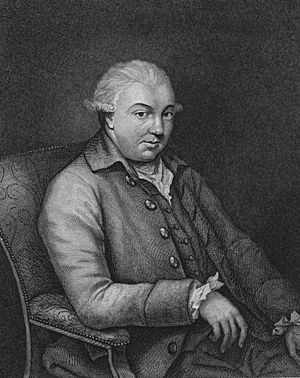Thomas Erskine, 6th Earl of Kellie facts for kids
Thomas Alexander Erskine (born September 1, 1732, died October 9, 1781) was a very talented Scottish musician and composer. He was also known as the 6th Earl of Kellie. During his life, he became famous around the world for his music. Even though he was well-known then, people didn't remember him much until recently. Now, new recordings of his music show that he was one of the most important British composers of the 1700s. He also played a big part in Scottish music.
Contents
Early Life and Musical Journey
Thomas Alexander Erskine was born in Edinburgh, Scotland. His father, Alexander Erskine, was the 5th Earl of Kellie. He was held in Edinburgh Castle because he supported the Jacobites in the 1745 uprising. Thomas's mother, Janet Pitcairn, was the daughter of a famous doctor and poet.
Thomas went to the Royal High School in Edinburgh. Around 1752, he traveled to Mannheim in Germany. There, he studied music with a famous composer named Johann Stamitz. This was a very important time for his musical training.
Becoming "Fiddler Tam"
After his father passed away in 1756, Thomas returned to Scotland. He was now a very skilled violinist and composer. People started calling him "Fiddler Tam" because of his amazing violin playing.
He brought a new style of music back with him, called the Mannheim style. He became known as the best British musician using this style. In 1761, six of his "Overtures" (which are like early symphonies) were published in Edinburgh.
Popular Compositions and Influence
One of his most popular pieces was an overture he wrote for a play called The Maid of the Mill. This play was performed in London in 1765 and his music became very famous.
In 1767, the Earl went back to Scotland. He became a key member of the Edinburgh Musical Society. He helped lead concerts at St Cecillia's Hall in Edinburgh, often playing the violin himself.
Leadership Roles
Thomas Alexander Erskine was also active in Freemasonry, a social and charitable organization. He was chosen as the fourth Grand Master of the Ancient Grand Lodge of England in London in 1760. He held this important position for six years. He also served as the twenty-fourth Grand Master Mason of the Grand Lodge of Scotland from 1763 to 1765.
A Close Call at Sea
In 1775, Thomas was returning from a trip to Europe. His ship almost sank in a storm in the English Channel. It was a very dangerous moment! A poem, thought to be written by his relative Henry Erskine, tells the story:
"In ancient story this I've found,
That no Musician e'er was drown'd.
A harp was then, or I mistake it,
Much better than the best cork-jacket;
…
'Twas thus the tuneful Peer of Kelly
Escap'd some whale's enormous belly;
And safe in London, thinks no longer
He'll prove a feast for shark or conger."
This poem suggests that musicians were lucky and wouldn't drown. It shows how Thomas survived the shipwreck.
Later Life and Legacy
The Earl of Kellie was known for enjoying life to the fullest. He even started a club for his friends. He often composed music on the spot. Sometimes, he would give his music away without thinking much about it.
His health began to decline. He traveled to Spa, Belgium, hoping to feel better. But on his way back, he became very ill. He passed away in Brussels.
Musical Works
For a long time, people thought only a few of Thomas Alexander Erskine's musical pieces still existed. However, in 1989, two collections of his music were found at Kilravock Castle. This discovery doubled the number of his known works! It included nine trio sonatas and nine string quartets.
People like John Purser have recently helped bring attention back to his music. Now, you can even find CDs of his compositions.
List of Compositions
Here are some of the musical pieces by Thomas Alexander Erskine:
- Sinfonia a Quattro in G major
- Sinfonia a Quattro in D major
- Quartet in C minor (with parts: Allegro, Andante, Allegro)
- Quartet in A Major (with parts: Allegro molto, Adagio, Minuet)
- Minuet
- The Favourite Minutes (including Lady Betty Stanley's Minuet)
- Overture in C major, Op. 1, No. 2 (with parts: Andantino, Presto assai)
- Overture in B Flat 'The Maid o the Mill' (with parts: Allegro, Adagio ma non troppo, Minuet (Rondo))
- Periodical Overture No. 16
- Periodical Overture No.17 in E-Flat Major (with parts: Andantino, Allegro con spirito, Presto)
- Death Is Now My Only Treasure
- The Lover's Message
- Lord Kelly's Reel
- Trio Sonata No. 5 in E (with parts: Andante con espressione, Minuetto)
- Trio Sonata No. 6 in G (with parts: Andantino, Tempo di Minuetto)


